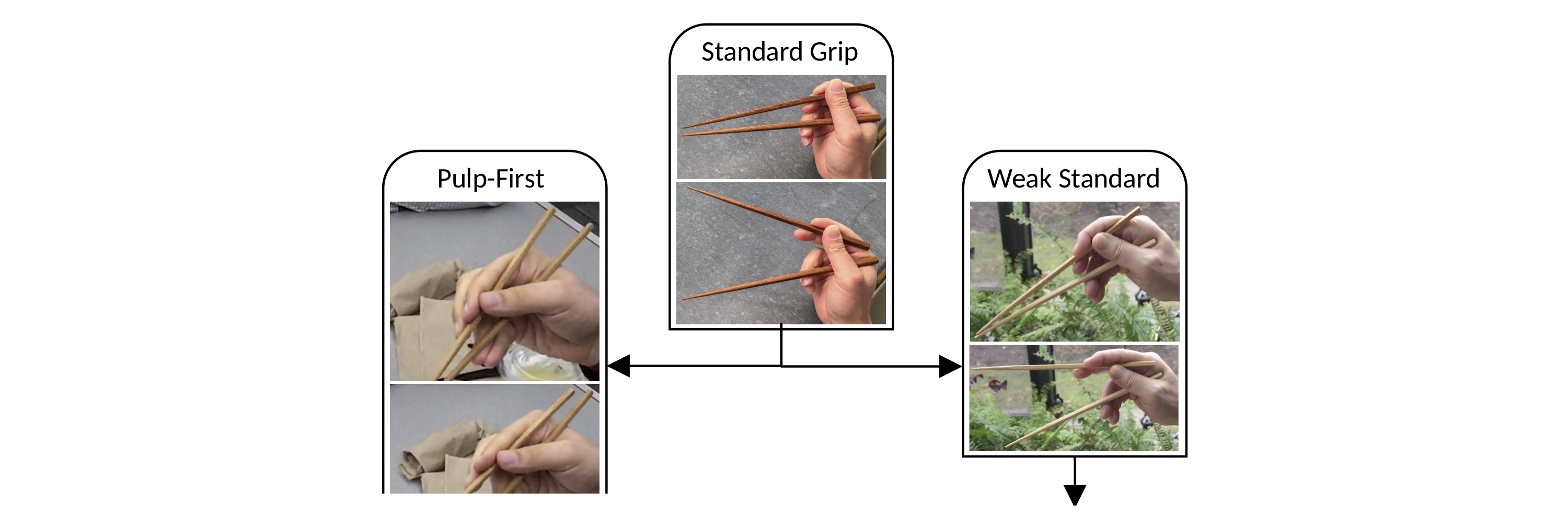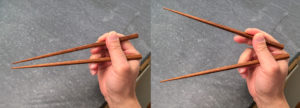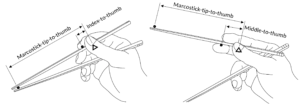Last Updated on August 9, 2021 by Staff
There are many ways for a human hand to grip a pair of marcosticks (read: chopsticks), and to wield them such that tips of chopsticks can be made to grasp and to release food items. However, only one grip is generally considered the best way to manipulate chopsticks, the Standard Grip.
That being said, through our research conducted in real-world situations, we have come to the realization that a great majority of lifelong chopstick users do not use the standard grip. Many have adopted alternative grips that are obviously different from the standard grip. Some appear, at a glance, to use the standard grip, but upon closer inspection do not.
A separate Ten Thousand Ways to Use Marcosticks article documents all alternative grips we have heard, photographed, and video-recorded, in real eating situations. These include for instance the Idling Thumb grip, the Vulcan Grip, and the Chicken Claws grip. They are classified by finger placement and finger movement, for each combination of top/bottom chopsticks and open/closed postures, in Classification of Chopstick Grips. These chopstick grips are all fine ways of using chopsticks. In the spirit of #utensilequality, all grips are equal at the dining table. We have captured this view in our retrospective, The Art and Science of Chopsticking.
This article provides a visual guide to grips that we have analyzed and published. A family tree illustrates how each alternative grip relates to the standard grip, based on the degree of its departure from the standard finger dynamics.
Click on each block below to read about the grip.
For the curious, we name grips by either distinguishing mechanism, or by resemblance. For instance, Idling Thumb, Dangling Stick and Forsaken Pinky are named by their distinguishing mechanisms. Chicken Claws, Muppet Grip, Vulcan Grip and Scissorhand are named after their resemblance to real world agents or objects.
The article will continue to be updated as more alternative grips are observed, recorded, analyzed, and posted to this site. If you are interested in learning to adopt the standard grip, go on to read Learn to Use Chopsticks. If you are interested in the research on the physics of chopsticks, check out History of Chopstick Research.
If you find our cause to your liking, you can make it yours, too. We do not need financial support at this time. But we can use your time to further our common cause. Head to the How to Help page.
As of Dec 2020, we have also started a new video series on YouTube, called “Ten Thousand Ways to Use Chopsticks”. This is the first episode:
We also have YouTube videos showcasing chopstick grips we have documented. The series “The Varieties of Chopsticking Experience” features chopstick grips from groups of related or associated people, to celebrate the ingenuity of folks who independently found grips that worked for them.
Previous versions:
- v1.0: 2020-01-08
- v1.1: 2020-02-03
- v1.2: 2020-02-08
- v1.3.1: 2020-02-18
- v1.5.1: 2020-02-22
- v1.6.1: 2020-02_26
- v1.7.1: 2020-03_19
- v1.8: 2020-03_28
- v1.9: 2020-04-18
- v2.0: 2021-01-24



